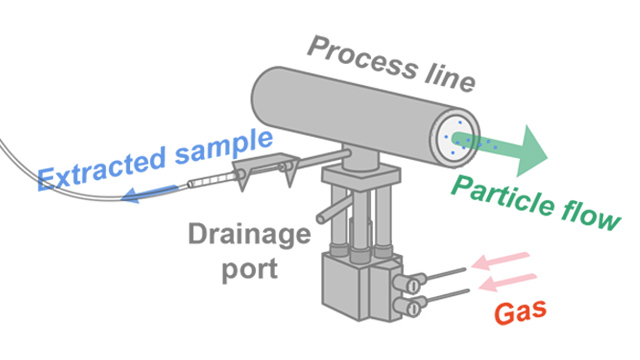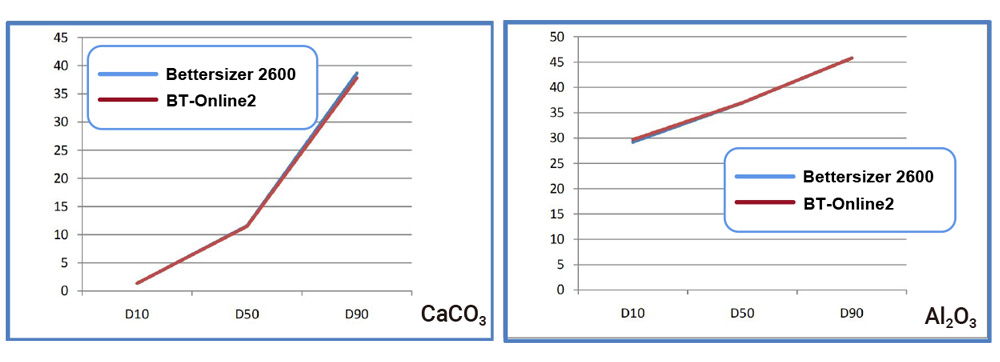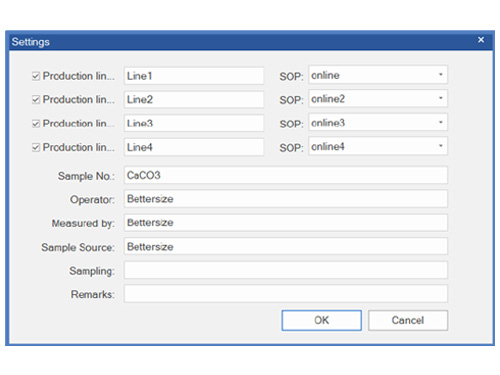BT-Online2
Le BT-Online2 applique le système optique de Fourier et de Fourier inverse breveté, fournissant des résultats de mesure fiables avec le même niveau de précision que celui de l'instrument de laboratoire. Un total de 92 détecteurs sont disposés avec précision dans la configuration optique qui est responsable de l'analyse précise de la taille des particules allant de 0,02 à 2000μm en utilisant la méthode humide. Avec un système de dilution externe, le BT-Online2 peut traiter des échantillons à forte teneur en solides, ce qui élargit considérablement ses domaines d'application. Jusqu'à 4 lignes de traitement peuvent être attachées au BT-Online2, ce qui permet d'économiser votre investissement, d'améliorer l'efficacité de votre espace et de simplifier la gestion des données.
Caractéristiques et avantages
- ● La configuration optique brevetée favorise la précision des mesures
- ● Système d'échantillonnage pneumatique fiable
- ● Surveillance d'un maximum de 4 lignes de processus
- ● Le système de dilution externe permet d'obtenir un obscurcissement optimal
- ● Même précision de mesure qu'un instrument de laboratoire
- ● Le système de filtration permet de recycler le solvant organique
Vue d'ensemble
BT-Online2 - Solution innovante pour la mesure en ligne par voie humide
Le BT-Online1 est utilisé comme analyseur de taille de particules en ligne pour les particules sèches dans la gamme de taille de 0,1 à 1000 μm. Le BT-Online1 est intégré dans une boucle de processus, fournissant des résultats de mesure en temps réel qui aident à l'inspection de la qualité et à la surveillance des paramètres.
La configuration optique brevetée favorise la précision des mesures
Le système optique de Fourier et de Fourier inverse breveté fourni par Bettersize Instruments contient des détecteurs avant, latéraux et arrière, réalisant la détection des signaux de lumière diffusée dans une très large plage angulaire.
Avantages de la configuration optique :
- La cellule d'échantillonnage inclinée atténue la réflexion interne totale.
- Extension de la plage de mesure
- Améliore la précision des mesures pour les petites particules.

Système d'échantillonnage pneumatique fiable
Cette conception permet
- une extraction efficace de l'échantillon sans contamination croisée
- Une bonne sécurité de fonctionnement sans utilisation d'électricité

Obtention d'une obscuration optimale par dilution externe
Dans la plupart des cas, la teneur en matières solides des échantillons est assez élevée, ce qui entraîne un obscurcissement important lorsque les échantillons sont introduits dans le BT-Online2. Un système de dilution externe est donc nécessaire pour la dilution primaire.

S'aligner sur l'instrument de laboratoire

Grâce à la vérification des performances, la valeur mesurée fournie par le BT-Online2 est cohérente avec la valeur nominale de l'étalon de référence de travail.

Les écarts de résultats entre le BT-Online2 et l'instrument de laboratoire sont très faibles - les courbes granulométriques se chevauchent presque.
Le système de filtration permet de recycler le solvant organique
Lorsqu'un solvant organique est utilisé comme vecteur au lieu de l'eau, un système de filtration mobile est disponible et fonctionne de pair avec le BT-Online2 pour recycler le solvant organique, ce qui permet d'économiser votre investissement.

Surveillance d'un maximum de 4 lignes de traitement
Jusqu'à 4 lignes de process peuvent être attachées au BT-Online2 avec des SOPs individuels. Le résultat de la mesure pour chaque ligne de processus est affiché intuitivement dans le logiciel, ce qui permet d'économiser l'investissement en équipement et de simplifier la gestion des données.

Application

- Mesures continues et précises dans diverses industries
Un système optique breveté permet d'obtenir des résultats de mesure précis avec une reproductibilité exceptionnelle.


- Procédure de mesure du BT-Online2 avec un système de dilution externe
En tant qu'accessoire, un système de dilution externe peut être connecté au BT-Online2, offrant une solution pour la mesure d'échantillons concentrés en cas de diffusion multiple. Le système de dilution externe possède 4 ports d'entrée qui correspondent à 4 lignes de traitement et 1 port de sortie pour délivrer l'échantillon primaire dilué.



Citations
- Bettersizer 2600
Functional redundancy as an indicator for evaluating functional diversity of macrobenthos under the mussel raft farm near Gouqi Island
DOI: 10.1016/j.aquaculture.2023.740024 Read ArticleZhejiang Ocean University | 2024Biological traits analysis (BTA) helps to evaluate the effects of different environmental variables on the traits-based functional composition of macrobenthos. However, research on functional traits of macrobenthos under mussel farming is limited. We investigated the spatial and temporal response of the benthic system in terms of taxonomic and functional diversity to environmental variables of farming and natural stressors resulting from suspended mussel farming near Gouqi Island of eastern China Sea. The functional traits of macrobenthic assemblages under mussel farming were characterized by “medium adult body size”, “vermiform body form”, “high flexibility”, “infauna”, “semi-motile”, “gonochoristic”, “surface deposit-feeders”, “carnivores”, “semi-motile burrowers”, and “tube-dwellers”. Functional redundancy was stable in response to mussel farming stresses among seasons, whereas species diversity showed efficient to evaluate natural variables. Functional diversity was significantly affected by farming stressors rather than natural variables, Further analysis using multivariate methods together with continuous monitoring were highlighted to evaluate the impacts of mussel farming. Our results reinforce the importance of macrobenthic species and functional traits analysis to evaluate human stresses driven impacts in offshore ecosystems. By analysing the environmental variables with different sources, independently, we concluded the main effects of human pressures on macrobenthic community. Such distinction could be particularly effective to isolate variable environmental descriptors and evaluate their effects on functional diversity, making the current approach promising for the evaluation of ecological effects of anthropogenic stressors in aquaculture areas. - Bettersizer 2600
Degradation characteristics and utilization strategies of a covalent bonded resin-based solid amine during capturing CO2 from flue gas
DOI: 10.1016/j.seppur.2023.125621 Read ArticleChina University of Petroleum | 2024In this study, various types of degradation as well as attrition which are possibly encountered in a circulating fluidized bed temperature swing adsorption (CFB-TSA) process, were conducted experimentally to evaluate the stability of a resin-based solid amine sorbent. Other characterizations methods, such as elemental analysis (EA), Fourier transform infrared spectroscopy (FTIR) etc. were applied to further reveal the degradation mechanisms. The results showed that thermal degradation occurs from 140–160 °C due to the decomposition of amine group. The CO2-induced degradation occurs from a higher temperature of 160–180 °C accompanied by the production of urea. Hydrothermal stability is good below 130 °C, but the ionic impurities in steam crystalized on particle surface can accelerate the degradation. Oxidative degradation is the most harmful, which starts at a lower temperature of 70–80 °C with the formation of aldehyde. The existence of H2O in atmosphere can alleviate the oxidative and CO2-induced degradations. The employed sorbent has a very low attrition index of 0.05, which is 1–2 orders lower than typical commercial fluidized bed catalysts. Based on the results of stability evaluation, some design suggestions for proper utilization of this sorbent or other similar resin-based sorbents have been provided in an industrial CFB-TSA process.
- Bettersizer 2600
De-branching of starch molecules enhanced the complexation with chitosan and its potential utilization for delivering hydrophobic compounds
DOI: 10.1016/j.foodhyd.2023.109498 Read ArticleShihezi University | 2024The current study aimed to prepare the complexes between debranched-waxy corn starch and chitosan polymers (DBS-CS), and then investigated their corresponding structural characteristics, rheological property and potent application in Pickering emulsion. The results indicated that the existence of chitosan significantly inhibited starch short-range molecular rearrangement for all DBS-CS samples, which was manipulated by both debranching treatment and chitosan content. Interestingly, this is the first study to reveal that the outstanding peak at 1.8 ppm in 1H NMR spectrum for sample DBS-CS was gradually shifted towards a lower-field region following an increased chitosan content. Moreover, the debranching treatment shifted the crystallinity pattern from A-type to B-type and the relative crystallinity of DBS-CS decreased gradually with the increased content of CS. All samples had a pseudoplastic fluid and shear-thinning behavior with an enhanced shear resistance following the complexation. The DBS-CS was applied in a Pickering emulsion for showing a greater emulsifying stability and a lower gel strength than native NS-CS prepared emulsion. Importantly, the encapsulation ability of curcumin in the DBS-CS emulsion was significantly improved, followed by an increase of 15.45% for its corresponding bioavailability compared to the control. Therefore, this study might highlight a potential carrier for delivering the bioactive substances in a green pattern. - Bettersizer 2600
Heat-induced aggregation behavior of wheat gluten after adding citrus pectin with different esterification degree
DOI: 10.1016/j.foodhyd.2023.109420 Read ArticleGansu Agricultural University | 2024Wheat gluten aggregation during heat treatment is beneficial to the final quality of gluten-based products. Exogenous pectin can affect gluten aggregation. However, the effect of pectin with different degrees of esterification on the heat-induced aggregation behavior of gluten and its possible mechanism are still unclear. Thus, the heat-induced aggregation behavior of gluten after adding pectin with different esterification degree was studied in this study. When the temperature was raised from 25 °C to 95 °C, pectin affected gluten aggregation and was related to the degree of esterification. Specifically, the results of rheological properties and particle size indicated that low-ester pectin improved the viscoelasticity of gluten and promoted gluten aggregation. Thermal properties revealed that enthalpy of gluten added with low-ester pectin (37%) increased from 92.96 J/g to 95.40 J/g during heating process. Structurally, the fluorescence intensity and surface hydrophobicity of gluten added with low-ester pectin (37%) were lower than those added with high-ester pectin (73%). In addition, low-ester pectin (37%) significantly increased the disulfide bond content (from 15.31 μmol/g to 18.06 μmol/g) and maintained β-sheet content of gluten compared with gluten alone at 95 °C, indicating that low-ester pectin was more likely to induce gluten aggregation. However, scanning electron microscope showed that the gluten added with low-ester pectin (46%) exhibited a denser network structure at 95 °C than that added with low-ester pectin (37%). These results will provide a theoretical base for the regulation of gluten aggregation and the quality of gluten-based products by pectin with different esterification degree.
- 1
- 2
- 3
- 4
- 5
- 6
- 84
Ressources sélectionnées
-
Bettersizer S3 Plus
Particle Size and Shape Analyzer
Measurement range: 0.01 - 3,500μm (Laser System)
Measurement range: 2 - 3,500μm (Image System)
-
Bettersizer ST
One-stop Particle Size Analyzer
Dispersion type: Wet
Measurement range: 0.1 - 1,000µm
Repeatability: ≤1% variation
-
Bettersizer 2600
Laser Diffraction Particle Size Analyzer
Measurement range: 0.02 - 2,600μm (Wet dispersion)
Measurement range: 0.1 - 2,600μm (Dry dispersion)
Measurement range: 2 - 3,500μm (Dynamic imaging)
-
BT-Online1
Online Particle Size Analyzer
Dispersion type: Dry
Measurement range: 0.1 - 1,000μm
Accuracy: ≤1% (D50 of certified reference material)











